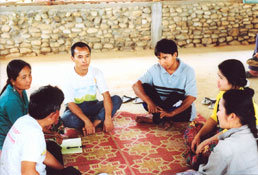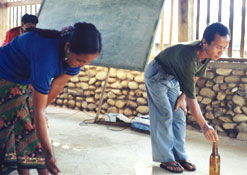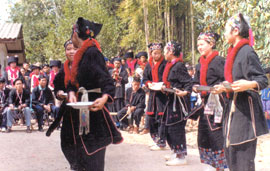| Background | |
| Hmong | |
| Khmu | |
| Yao | |
| Lahu | |
| Akha | |
| Stories | |
| Schedule | |
| Sponsorship | |
| Contact | |
| Yao team | ||||
The Yao theatre team lives in Khunbong
village, in Ton Pheung district, Bokeo province in the neighbouring
village to the Lahu team. Their village is split through the middle
by a broad dusty road leading from the district to the provincial
capital. There is a women’s embroidery group in the village,
who work together during the day by the side of the road and sell
their products to passing traders. |
||||
 |
 |
|||
The team members are between 16 and 45 years old, some are already married with children, others have just left school. The village has a small hall, which is used for meetings, theatre rehearsals and for adult learning classes in the evenings. Before the theatre activity started, villagers could not remember the last time they had sung a song in Yao language. But as the actors started interviewing older members of the community, they discovered that a treasure trove of music from the past was hidden in their village. |
||||
| Yao history and culture | ||||
The Yao or Mien originated in Southern
China about two thousand years ago. They speak a language belonging
to Sino Tibetan family. There are around 22,000 Yao living in Laos
today. |
||||

|
||||
They excel in the making of metal farm implements such as axes and plows. Because they've long had a written language, they also know how to make high quality paper. The Danu Festival, also known as the King Paugu Festival, held on the Yao New Year's day is most important for the Yaos. Paugu, the king and hero of the Yao, incarnated as a dog, is said to have protected the Yaos and helped them develop into peaceful and wealthy communities. The Yao are regarded as a peace loving people who seek orderliness and perfection in their lives. |
||||